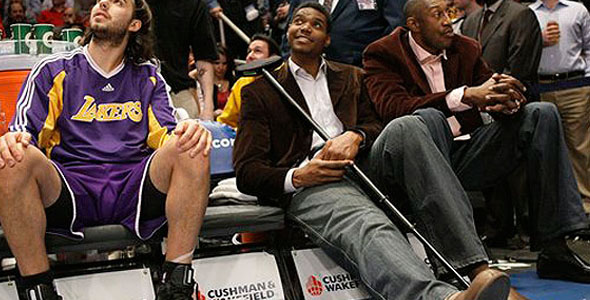Andrew Bynum had his mid-season injury as predicted, but how will this affect the team? In the third quarter of Friday’s win over Minnesota, Andrew Bynum suffered a strained Achilles tendon. To assess how this will affect the Lakers, let’s take a look at Bynum’s production against some of the teams with the best records in the league:
Andrew Bynum 2009-2010 |
||
| PPG | RPG | BPG |
v. Orlando |
||
| 6.5 | 7.0 | 2.0 |
v. Denver |
||
| 11.6 | 8.6 | 1.0 |
v. Dallas |
||
| 17.0 | 9.0 | 0.6 |
v. Boston |
||
| 16.5 | 10.0 | 1.0 |
v. Cleveland |
||
| 5.5 | 7.0 | 1.0 |
Against these top teams this season, Bynum has averaged (in 12 games): |
||
| 11.9 ppg | 7.1 rpg | 1.6 bpg |
Bynum tends to play better when he’s not facing an elite big man (or even Nene). His numbers against the Cavs and Magic are pitiful. His numbers are skewed because he out-played the Mavs and Celtics, who lack dominant centers (Brendan Haywood and Kendrick Perkins, respectively).
What these trends suggest is that the Lakers might miss Bynum’s production more in the western conference playoffs than in the NBA Finals.
Let’s face it—chemistry this season has been a problem. The flow and balance of the team just has not been right. Removing Bynum leaves the Lakers with a starting lineup of:
C Pau Gasol, F Lamar Odom, F Ron Artest, G Kobe Bryant, G Derek Fisher
I would argue that the injury to Bynum, while obviously a negative, actually improves the starting lineup. Hopefully, the combination of Artest and Odom, old New York street ball buddies, will improve team chemistry.
Of course, the downside is that the Lakers bench, as weak as it has been this season, will become even weaker. As Phil Jackson pointed out in his post-game interview, “we really know how to play without Andrew…its about the support system behind that…” (Jackson).
As for that, the only hope for their bench is that some of the players who used to be effective can find their games and contribute. Here’s looking at you: Sasha Vujacic. Vujacic is having his worst season since his rookie year in almost every statistical category, most noticeably points (2.5 ppg in 2010 v. 8.8 in 2008). We’d talk about Luke Walton’s lack of production, except that he’s out for the season indefinitely with a pinched nerve in his back. With Bynum out for a while, Josh Powell will get more minutes, but can he provide more than the 2.7 ppg and 1.6 rpg he has averaged thus far. Jordan Farmar, on the other hand, is doing better than last season with 7.3 ppg, but only 1.6 apg. The other lone highlight of the bench, with Odom moving into the starting lineup, is Shannon Brown. Brown has improved his numbers from last season with 8.0 ppg and less than a turnover per game (0.83).
Bynum will probably return earlier rather than later, according to Laker reports. It sounds like he’ll be back by early April. However, whether he will be himself or the Bynum he was during last year’s playoffs, we’ll have to wait and see. While I’d like to think that he could return to form, more than likely his production will be limited like last post-season.
After beating San Antonio in their first game of the Lakers’ five-games road trip, the Lakers now have to focus on the other good teams on this trip, like Oklahoma City and Atlanta.
It will be a tough challenge, but I have a feeling the Lakers will find their way. Playing against better competition, they’ll be more focused. Against Washington, the Lakers lost early leads and let the game get much closer than it should have been. Nearing the end of the season is not the right time for these types of minor regressions, not for a championship team.
R.S. De France is a College and University instructor of English Composition. He has a B.A. in English and an M.A. in Rhetoric, Composition, and Writing. One of his life-long pursuits has been writing and covering anything related to sports, specifically the NBA. Recently, De France, his wife, and another colleague started an internationally read magazine at Shwibly.com.














